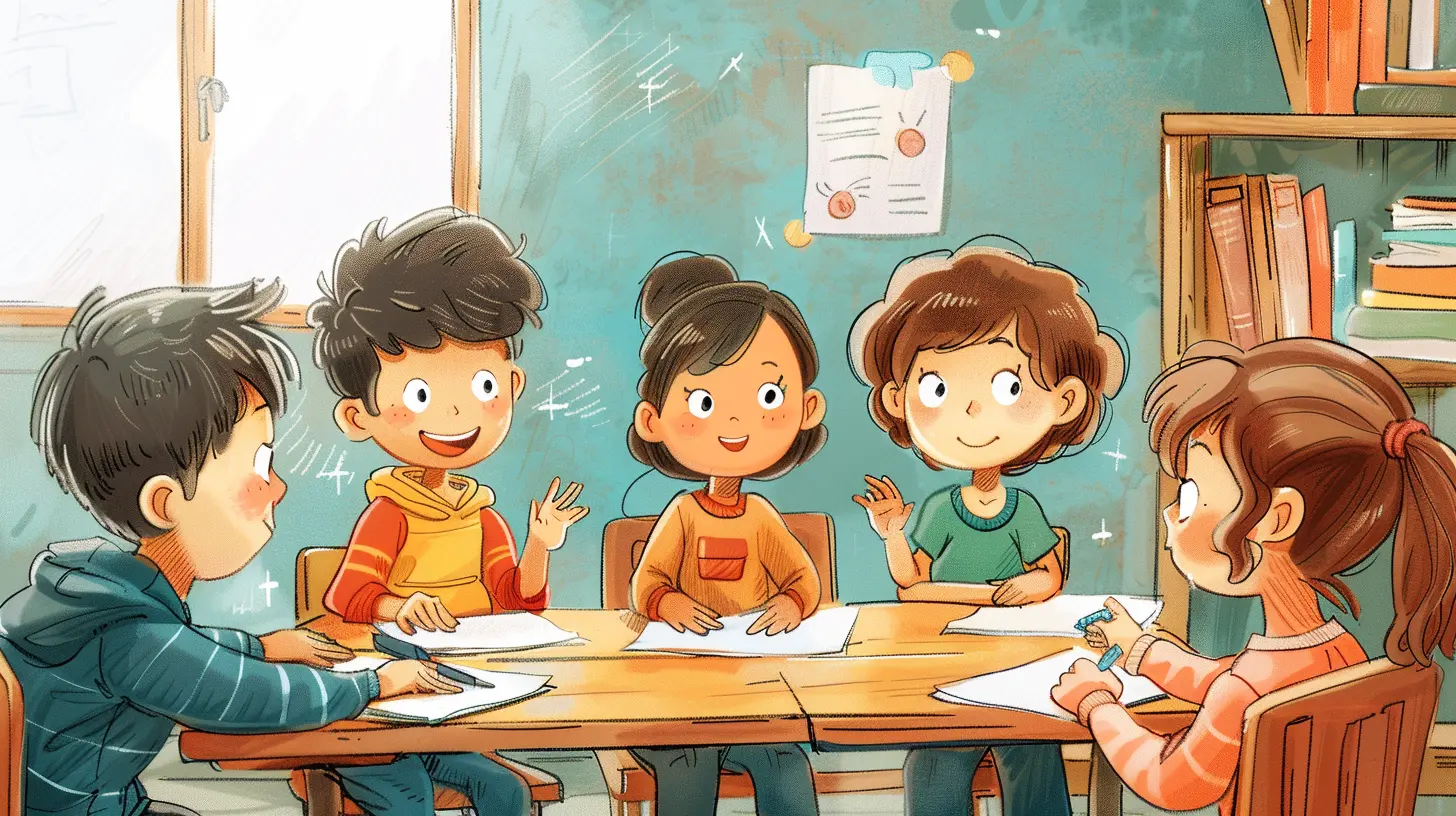How to Motivate Reluctant Students to Engage in Group Work
16 December 2024
Group work can be incredibly beneficial in the classroom. It encourages communication, teamwork, and allows students to learn from one another. But let’s get real here—motivating reluctant students to engage in group work can sometimes feel like trying to pull teeth. Not everyone loves the idea of working in a group, and for some students, the thought of collaborating with others is downright intimidating.
So, how do you get those reluctant students out of their shells and excited to participate in group work? Whether you’re a teacher, parent, or someone who works with students, the strategies in this article will help you understand why some students resist group work and how to motivate them to get onboard.

Why Do Some Students Resist Group Work?
Before we dive into the strategies to motivate students, it's important to understand why some students are reluctant. You can't solve a problem unless you know what's causing it in the first place, right? Here are a few reasons why some students shy away from group work.
1. Fear of Judgment or Embarrassment
We’ve all been there. The fear of saying or doing something wrong in front of others can be paralyzing, especially for students who are already self-conscious. For them, group work can feel like a stage, and they’re not eager to be in the spotlight.2. Introversion
Some students simply prefer working alone. It’s not that they can’t work in groups, but they may find it draining or uncomfortable. Introverts often thrive in quieter, more individual settings, and the hustle and bustle of group work can be overwhelming for them.3. Lack of Confidence
Students who lack confidence in their academic abilities may avoid group work because they fear they won’t pull their weight or contribute value. They’d rather stay on the sidelines than risk being the “weak link.”4. Previous Negative Experiences
A bad experience in the past—like a group where one person did all the work, or where their ideas were ignored—can leave a sour taste in a student’s mouth. They might associate group work with frustration or failure and would prefer to avoid it altogether.5. Perception of Unfairness
Let’s face it, sometimes group work feels like anything but teamwork. If one or two students end up doing all the work while others coast along, it can create resentment and a reluctance to engage in future group projects.
How to Motivate Reluctant Students to Engage in Group Work
Now that we’ve explored the reasons behind the reluctance, let’s move on to the good stuff. Here’s how you can motivate even the most hesitant students to engage in group work.1. Create a Safe Environment
First things first: students need to feel safe in order to participate. When students feel that they won’t be judged or ridiculed for their contributions—or lack thereof—they’re more likely to engage. Creating a classroom culture of respect and understanding is key.How to Do It:
- Encourage small wins: Start with smaller, low-stakes group activities so students can get comfortable working with others without the pressure of a major project.- Model respect: Show students that every contribution matters by actively listening to all ideas during group discussions.
- Establish ground rules: Set clear expectations for how group members should treat each other. Emphasize kindness and inclusion.
2. Provide Clear Instructions
Sometimes students resist group work simply because they’re not sure what’s expected of them. Confusion can lead to frustration, and frustration can lead to disengagement. Make sure students know exactly what they need to do and how they should do it.How to Do It:
- Break tasks into steps: Lay out exactly what needs to be done, step by step. When the task is clear, students will feel more confident in their ability to contribute.- Assign roles: Giving each student a specific role (like note-taker, researcher, or time-keeper) can help them understand their responsibilities within the group.
3. Highlight the Benefits of Group Work
Sometimes, students just don’t see the point of working in groups. They might think, “I can do this faster by myself!” That’s where you come in. Show them the benefits of group work, and they might just change their minds.How to Do It:
- Explain the real-world relevance: In the real world, people rarely work in isolation. By working in groups, students are practicing skills they’ll need in the workplace—like collaboration, communication, and problem-solving.- Emphasize peer learning: Group work allows students to learn from their peers. Explain that everyone has strengths and weaknesses, and working together allows them to tap into each other's unique knowledge and skills.
4. Incorporate Student Interests
One surefire way to get students more engaged in group work is to make the tasks relevant to their interests. When students care about what they’re doing, they’re more likely to participate actively.How to Do It:
- Offer choice: Whenever possible, give students options when it comes to group projects. Let them choose topics or activities that align with their interests. This gives them a sense of ownership and makes the work feel more meaningful.- Connect to real-life situations: Try to design group work that ties into students’ real-life experiences or future goals. If they can see how what they’re doing applies to their lives, they’ll be more motivated to participate.
5. Foster Positive Group Dynamics
The success of group work often depends on the chemistry between group members. If students don’t get along or if one person dominates the group, it can lead to resentment and disengagement. Your job is to foster positive group dynamics where everyone feels valued.How to Do It:
- Mix up the groups: Don’t always let students choose their own groups. Sometimes, pairing students with different personalities or skill sets can create a more balanced dynamic.- Teach teamwork skills: Don’t assume students know how to work effectively in a group. Take the time to teach them how to collaborate, compromise, and communicate.
- Address conflicts: Be proactive about addressing any tensions or conflicts that arise within groups before they spiral out of control.
6. Use Technology to Your Advantage
Let’s face it, technology is a big part of students' lives. Why not use it to make group work more engaging? Online tools and apps can make collaboration easier, especially for students who are more tech-savvy.How to Do It:
- Incorporate collaborative tools: Use platforms like Google Docs, Trello, or Slack to facilitate group work. These tools allow students to collaborate in real-time, even outside of class.- Gamify the experience: Turn group work into a game by introducing friendly competition. For example, you could offer rewards for the most creative project or the group that works together the best.
7. Praise Effort, Not Just Results
Some students are reluctant to engage in group work because they’re afraid of failing or not meeting expectations. By focusing on the process rather than just the outcome, you can alleviate some of that pressure and encourage participation.How to Do It:
- Acknowledge progress: Even if the final product isn’t perfect, make sure to recognize and praise the effort students put into the collaboration.- Give constructive feedback: Offer feedback that focuses on how students can improve their group work skills rather than just criticizing the end result.
8. Allow for Reflection
Reflection gives students the opportunity to think about what worked and what didn’t during the group work process. It helps them understand their own contributions and areas for growth, making them more likely to engage in future group tasks.How to Do It:
- Ask reflective questions: After a group project, ask students to reflect on their experience. What did they learn from their peers? What challenges did they face, and how did they overcome them?- Encourage self-assessment: Have students evaluate their own participation and that of their group members. This can help them take ownership of their contributions and recognize the value of teamwork.

Conclusion
Motivating reluctant students to engage in group work doesn’t have to be an uphill battle. By creating a supportive environment, providing clear instructions, and making the work relevant to their interests, you can encourage even the most hesitant students to participate. Remember, the goal is not just to get them to work in groups but to help them see the value in collaboration. After all, teamwork is a skill they’ll use for the rest of their lives—both in and out of the classroom.So whether you’re dealing with an introverted student who prefers working alone or a student who’s had a bad experience with group work in the past, these strategies will help you guide them toward more positive and productive group experiences.
all images in this post were generated using AI tools
Category:
Group WorkAuthor:

Fiona McFarlin
Discussion
rate this article
18 comments
Nymira Lawson
Motivating reluctant students requires understanding their fears and fostering a safe, inclusive environment. Genuine connections can transform group work from a chore into a collaborative adventure.
February 9, 2025 at 1:31 PM

Fiona McFarlin
Absolutely! Building genuine connections and addressing fears are key to creating an inclusive environment that encourages collaboration and transforms group work into a meaningful experience.
Skyler Chavez
Engaging reluctant students in group work can ignite their passion for learning. By fostering a supportive environment and highlighting individual strengths, we can empower every learner to shine.
February 1, 2025 at 4:57 AM

Fiona McFarlin
Thank you for your insightful comment! I completely agree that creating a supportive environment and recognizing individual strengths are key to motivating reluctant students in group work. Empowering them can truly ignite their passion for learning!
Lyanna McAdams
Empower reluctant students by fostering a supportive environment; collaboration sparks creativity and builds confidence. Every voice matters!
January 25, 2025 at 12:59 PM

Fiona McFarlin
Thank you for your insightful comment! Creating a supportive environment is indeed key to empowering students and enhancing their engagement in group work.
Oliver Russell
Great insights! Engaging reluctant students in group work requires understanding their perspectives. Incorporating their interests, offering choices, and establishing a safe environment can significantly boost participation. Fostering collaboration and ensuring each student feels valued are key strategies to enhance motivation and teamwork.
January 21, 2025 at 7:58 PM

Fiona McFarlin
Thank you for your thoughtful comment! I completely agree that understanding students' perspectives and fostering a safe, inclusive environment are essential for motivating reluctant learners in group work. Your insights on incorporating interests and offering choices are spot on!
Easton McMichael
Inspiring collaboration transforms reluctance; understanding their perspectives ignites intrinsic motivation for engagement.
January 17, 2025 at 5:45 AM

Fiona McFarlin
Thank you for your insightful comment! Collaboration and understanding are indeed key to fostering motivation in reluctant students.
Jasmine Gomez
Empower reluctant students by fostering a supportive environment. Celebrate small wins, encourage collaboration, and ignite their passion for learning—together, we can transform their engagement!
January 15, 2025 at 3:52 AM

Fiona McFarlin
Thank you for highlighting the importance of a supportive environment! Celebrating small wins and promoting collaboration are key strategies in boosting engagement among reluctant students. Together, we can cultivate a love for learning!
Quentin McCullough
Fostering a sense of belonging and purpose can transform group work for reluctant students. Empower them with ownership, and watch their engagement and collaboration flourish.
January 8, 2025 at 11:35 AM

Fiona McFarlin
Absolutely! Empowering students with ownership creates a supportive environment where they feel valued, leading to increased engagement and collaboration.
Callie Mendoza
Empowering reluctant students through engaging group work fosters collaboration and boosts confidence. Ignite their passion for learning by creating a supportive environment where every voice truly matters!
January 4, 2025 at 12:55 PM

Fiona McFarlin
Thank you for your insightful comment! Creating a supportive environment and fostering collaboration are indeed key to motivating reluctant students. Every voice matters in inspiring a passion for learning!
Lara Morris
In a world where curiosity often lies dormant, unlocking the hidden potential of reluctant students can be a captivating journey. Discover the secrets of fostering connection and igniting passion within group work. What if the key to motivation lies in the stories yet to be told? Unravel the mystery.
January 1, 2025 at 9:58 PM

Fiona McFarlin
Thank you for your insightful comment! Indeed, tapping into personal narratives can be a powerful way to spark motivation and foster deeper connections in group work. Let's explore these stories together!
Danica McQuillen
This article raises intriguing strategies for engaging reluctant students in group work. I'm particularly curious about how incorporating student interests and diverse learning styles can foster a more inclusive atmosphere. It would be interesting to see real-life examples of these methods in action—what has worked well in different classroom settings?
December 29, 2024 at 8:41 PM

Fiona McFarlin
Thank you for your thoughtful comment! I completely agree that incorporating student interests and diverse learning styles is key to fostering inclusivity. In my article, I highlight several real-life examples, such as using choice-based projects and flexible roles, which have proven effective in various classroom settings.
Reid Navarro
Engaging reluctant students in group work requires a strategic approach. Foster a supportive environment, emphasize the value of collaboration, and set clear, achievable goals. Encourage peer accountability and celebrate successes. With consistent effort and positive reinforcement, you can transform disengagement into enthusiastic participation. Let's inspire our students to thrive together!
December 25, 2024 at 9:28 PM

Fiona McFarlin
Thank you for your insightful comment! Emphasizing collaboration and celebrating successes are key strategies in motivating reluctant students. Let's continue to inspire and uplift our learners together!
Damien Blair
Understanding their fears can spark their willingness to engage.
December 22, 2024 at 7:37 PM

Fiona McFarlin
Absolutely! Addressing students' fears creates a safe space for them to express themselves and fosters greater engagement in group work.
Spencer McMahan
Inspire the hesitant hearts; let collaboration bloom, In shared dreams and laughter, spark the light in every room.
December 22, 2024 at 1:52 PM

Fiona McFarlin
Thank you for beautifully capturing the essence of collaboration! Inspiring hesitant hearts and fostering a supportive environment are key to engaging reluctant students in group work.
Vivian McCarthy
Incorporate student interests and diverse roles to foster engagement and encourage collaboration in group work.
December 22, 2024 at 5:37 AM

Fiona McFarlin
Absolutely! By integrating students' interests and assigning varied roles, we can enhance engagement and promote collaboration, making group work more appealing and effective for everyone.
Troy McGuffey
Engaging reluctant students in group work requires fostering a sense of belonging and purpose. By incorporating relevant topics, setting clear expectations, and utilizing peer support, educators can create an inclusive environment that encourages participation and collaboration, ultimately enhancing the learning experience for all.
December 20, 2024 at 8:47 PM

Fiona McFarlin
Thank you for your insightful comment! Fostering belonging and purpose is indeed key to motivating reluctant students in group work. Your suggestions on relevant topics and peer support are valuable strategies for creating an inclusive learning environment.
Dominic Mahoney
Great insights! I love how you highlighted the importance of fostering a supportive environment. Connecting group work to students' personal interests can truly spark their motivation. Looking forward to trying out your tips in my own classroom—thank you for sharing such practical strategies!
December 20, 2024 at 5:01 AM

Fiona McFarlin
Thank you for your kind words! I'm glad you found the strategies helpful. Best of luck in your classroom!
Jet Cole
Great insights! To further enhance engagement, consider incorporating student interests into group projects or using role assignments that play to individual strengths. Additionally, fostering a supportive environment where students feel safe to express ideas can significantly boost their motivation to participate. Keep up the good work!
December 17, 2024 at 9:36 PM

Fiona McFarlin
Thank you for your thoughtful suggestions! Incorporating student interests and fostering a supportive environment are excellent strategies to boost engagement. I appreciate your feedback!
Lira Foster
Great insights! Encouraging reluctant students to participate in group work can transform their learning experiences. Building a supportive environment and fostering a sense of belonging are key to unlocking their potential and igniting their enthusiasm.
December 16, 2024 at 9:57 PM

Fiona McFarlin
Thank you! Creating a supportive environment is indeed crucial for encouraging participation and enhancing the learning experience for reluctant students.
MORE POSTS

Creating Engaging Content for Blended Learning Courses

Rethinking Traditional Summative Assessments in the Arts and Humanities

The Benefits of Collaborative Learning in Inclusive Classrooms

How to Stay Organized While Studying Online

How to Create a Customized Homeschool Curriculum for Your Child

How Creative Exercises Can Boost Student Motivation

How to Deal with Homework Overload During Busy Weeks

The Magic of Static Electricity: Easy Experiments with Shocking Results

How History Informs Modern-Day Political Systems

Student Exchange Programs: A Pathway to Global Scholarships

The Benefits of Collaborative Group Work for Student Outcomes